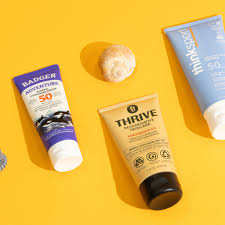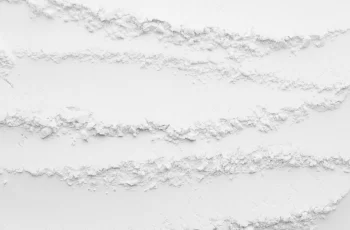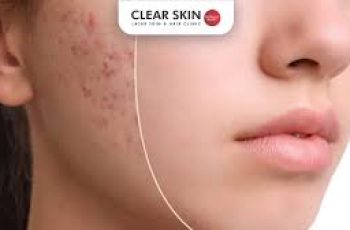
The Science of Titanium Dioxide in Skincare
Titanium dioxide is a white powdered mineral found in just about everything from skincare to Skittles. It’s a valuable ingredient in skincare, especially in sunscreen and makeup.
But what makes titanium dioxide so special? And is it safe for everyday use? Let’s take a closer look at why this ingredient is a true precious metal in skincare!
Before we get started: Find your skin type and the best products by taking your free Baumann Skin Type Test today!
What is Titanium Dioxide?
Titanium dioxide (TiO2) is a naturally occurring mineral known for its ability to reflect light. This makes it ideal for protecting your skin from the sun’s harmful rays.
There are two main types of TiO2 used in skincare: rutile and anatase. Rutile is more stable and doesn’t break down in the sun, so it’s favored in many products.
Anatase is another effective form, but is less stable to UV rays. Both forms protect your skin from the sun.
Benefits of Titanium Dioxide
Titanium dioxide has several notable benefits in skin care:
UV protection: TiO2 is a physical sunscreen, or h. It sits on the skin and reflects incoming UV rays.
It protects against both UVA and UVB rays, thereby preventing sunburn, skin aging, and skin cancer.
Skin-friendly: Unlike some chemical sunscreens that can cause irritation or allergies, TiO2 is generally gentle and well tolerated.
Great for makeup: In makeup, TiO2 provides coverage and brightening effects for a smooth, even finish.
Safety of Titanium Dioxide
Numerous studies have proven that titanium dioxide is very safe for use in skin care.
For example, the U.S. Food and Drug Administration (FDA) and the European Commission’s Scientific Committee on Consumer Safety (SCCS) have confirmed that titanium dioxide is safe to use in cosmetics.
Including sunscreens, as long as the instructions for use are followed.
Studies have shown that while TiO2 can penetrate the outer layers of the skin, it cannot be absorbed deeper or enter the bloodstream.
Research is still ongoing on the safety of inhaling TiO2 nanoparticles, and it doesn’t seem wise to do so. In other words, if you use sunscreen powder, don’t inhale micronized titanium dioxide.
Titanium Dioxide Sunscreen
Titanium dioxide is a key ingredient in many sunscreens. Here’s how it works:
Particle size: In sunscreen, TiO2 particles are often made smaller (micronized) so that they are less noticeable on the skin while still protecting you from the sun.
These particles can range in size from 100 to 200 nanometers, and sometimes even smaller (nanoparticles), less than 100 nanometers.
Effect: TiO2 particles settle on the surface of the skin and reflect UV rays like tiny mirrors. This physical barrier prevents harmful rays from reaching your skin.
If you’re looking for the best sunscreen with titanium dioxide, check out this:
Is titanium dioxide comedogenic?
Some ingredients can clog pores and cause acne. Titanium dioxide is not one of them. Therefore, it’s a good choice for people who are acne-prone or have sensitive skin.
However, as with any product, you should be mindful of your skin’s reaction.
Also note that many sunscreens need to be washed off. Heavy cream sunscreens that leave a residue behind can cause acne if not washed off.
Is Titanium Dioxide Reef-Friendly?
Unlike some chemical sunscreens, titanium dioxide in non-nano form is considered harmless to coral reefs. However, the situation is different with nanoparticle-sized titanium dioxide.
Studies have shown that these smaller particles are toxic to fish and other marine life.
Therefore, when looking for a reef-friendly sunscreen for a beach or ocean vacation, it is important to choose a product that contains non-nano TiO2 and avoid harmful additives that can harm marine ecosystems.
What are Nanoparticles?
Nanoparticles are extremely small particles that are less than 100 nanometers in size.
Nanoparticles of titanium dioxide and zinc oxide are both used in sunscreens to make them softer on the skin.
However, studies have shown that, despite concerns, these nanoparticles do not penetrate healthy, intact skin and reach living cells.
Nanoparticles, or micron-sized metals such as TiO2, clump to a lesser extent when applied to the skin than larger particles.
Zinc Oxide vs. Titanium Dioxide
Both zinc oxide (ZnO) and titanium dioxide (TiO2) are commonly used physical sunscreens, but they have some important differences:
UV protection: Zinc oxide offers broader protection and covers a wider range of the UVA and UVB spectrum. Titanium dioxide is often used with zinc oxide for enhanced protection against UVB.
Aesthetics: Titanium dioxide is not as brightening as zinc oxide, so it is more aesthetically pleasing in products that require a clear or tinted finish.
Safety: Both are safe and non-irritating, suitable for sensitive skin.
What is titanium dioxide? Is it the same as TiO2?
Titanium oxide can refer to various titanium oxides, but titanium dioxide (TiO2) is generally used in skin care.
So when we talk about titanium dioxide in sunscreen or cosmetics, we are referring to TiO2.
There are other titanium dioxides, such as TiO, Ti2O3, and Ti3O5, but these are rarely used in skin care.
Titanium Dioxide in Cosmetics
Titanium dioxide is used in cosmetics because it conceals imperfections and makes the skin glow. It gives a smooth, even finish to foundation, concealer, and powder.
Its UV-blocking properties give your makeup extra protection from the sun. With sunscreen ingredients like TiO2 in your cosmetics, you can let your beauty be your shield.
Summary
Titanium dioxide is a useful ingredient in sunscreens and cosmetics.
Its ability to protect the skin from harmful UV rays, combined with its gentle, pore-protecting properties, makes it an essential ingredient in sunscreens and cosmetics.
Despite concerns about nanoparticles and environmental impacts, current research suggests that titanium dioxide is safe in most situations.
To tailor your skincare routine to your individual needs, take the Baumann Skin Type Test to find and select the best products for your skin type!


